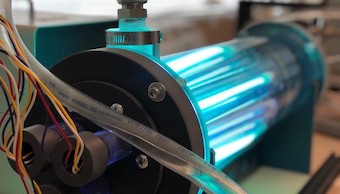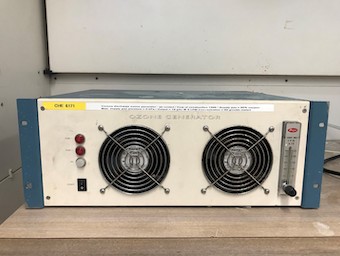INSTRUMENTS
 High Performance Liquid Chromatography
High Performance Liquid Chromatography
Model: UltiMate 3000
Target Compounds: Microcystins, Pharmaceutical Contaminants, Pesticides,etc.
The UltiMate 3000 High Performance Liquid Chromatography is a unique machine and one of the cornerstones of our lab. It separates, identifies and quantifies organic components dissolved in a liquid solvent with a high analytical resolution. It is equipped with the LPG-3400SD Standard Quaternary Pump that supports pressures up to 62MPa (9,000psi/620 bar) at flow rates up to 10mL/min. It can accommodate up to four solvents that can be used for convenient method development and system flushing. UltiMate 3000 HPLC also accommodates the VWD-3400RS detector for measurements up to 200Hz and can record up to four wavelengths simultaneously. For maximum peak resolution, our lab members use two different types of analytical columns, Nova-Pak C18 column which is based on a 4μm particle technology and XSelect CSH C18 column that is packed with particles of size 3.5μm.
 Total Organic Carbon
Total Organic Carbon
Model:
1)Shimadzu ASI-V TOC analyzer (Shimadzu Corp., Kyoto, KP,Japan) or (Mandle, Canada)
2)Sievers M5310 C-TOC analyzer+ Sievers Autosampler. (Suez water technology and solution, Boulder, CO, USA)
Target Compounds: Natural Organic Matter
 Ion Chromatograph
Ion Chromatograph
Model: Thermo Scientific Dionex™ ICS-1100 Ion Chromatography System (Dionex ICS-1100)
Target Compounds: Sulfate, Nitrate, Phosphate, Nitrite, Iodide, Bromide, Fluoride, etc.
The Thermo Scientific Dionex™ ICS-1100 Ion Chromatography System (Dionex ICS-1100) performs ion analyses using suppressed or non-suppressed conductivity detection. An ion chromatography system typically consists of a liquid eluent, a high-pressure pump, a sample injector, a guard and separator column, a chemical suppressor, a conductivity cell, and a data collection system. The ion chromatography system is calibrated using a standard solution. By comparing the data obtained from a sample to that obtained from the known standard, sample ions can be identified and quantitated. The data collection system, typically a computer running chromatography software, produces a chromatogram (a plot of the detector output vs. time). The chromatography software converts each peak in the chromatogram to a sample concentration and produces a printout of the results. Typically, most of the inorganics such as fluoride, chloride, nitrite, bromide, nitrate, phosphate and sulfate can be detected.

Solid Phase Extractor
Model: Visiprep SPE Vacuum Manifold
Target Compounds: Perfluorinated Compounds, Microcystins, etc.
The Visiprep SPE Vacuum Manifold is used for sample preparation by performing solid phase extraction. This unit can be used for sample extraction, concentration and cleanup prior to analysis. The unit available at our lab is capable of processing 12 samples simultaneously. There are two types of SPE tubes that are currently being used by our students. One is Sep-Pak tC18 3cc Vac Cartridge, which is used to concentrate biological samples. While the other is Oasis WAX 3 cc Flangeless Vac Cartridge which is used for concentrating water samples containing PFOS.
 Sonicator
Sonicator
Maximum tank service capacity: 5liter.

Furnace
Model: THERMO SCIENTIFIC Box Furnace
Range: 100-1100 C
THERMO SCIENTIFIC Box Furnace provide a heat source to heat, dry and process samples and materials at high temperature and evenly distributed heat. Technical Data: Air vent (1 in. dia., top) and air inlet (0.375 in. dia., rear) for inert atmosphere exchange.

Shaking Incubator
Model: Jeio Tech SI-600 Shaking Incubator
Jeio Tech SI-600 Shaking Incubator offer stable temperature conditions and orbital and reciprocating agitations at variable speeds for cell culturing and solubility studies. Technical Data:
Collaborative Instruments
-
Ultra Higher Performance Liquid Chromatography (uHPLC)-Mass Spectrometer (MS): Perfluorinated compound analysis
-
Inductively coupled plasma mass spectrometry (ICP–MS): Metal analysis
- Liquid Chromatography with Organic Carbon Detection (LC-OCD): Organic matter characteristics
- Flow cytometry: Pathogen cell count
Experimental Set-Ups

Rapid small scale column (BIEX)
Continuous small-scale media filtration columns: When installed, most water treatment technologies are in nonstop operation, not in batch mode as seen with many lab experiments. The Continuous small-scale media filtration columns consist of four parallel columns with a continuous feed. Designed to compared filtration media types or source water variations, four parallel one-inch columns have alike operating conditions. With mesh screens at the base, various media such as ion exchange resins or granular activated carbon can be installed in the columns, and compared over 4-, 6-, or 12-month or longer experiments. Influent water can be synthetic or sourced from a local stream, and then pumped to the top of the column with a continuously-operating peristaltic pump. Sample from the effluent of each column are taken at regular intervals for a full water quality analysis to asses the treatments’ effectiveness.
UV-LED Setup
Our in-house UV-LED collimated beam apparatus is the first evaluated collimated beam apparatus setup serve both advanced oxidation and disinfection processes. It is used to test advanced oxidation processes or disinfection studies using ultraviolet light emitting diodes at different wavelengths. Different doses can be delivered to a target samples to validate UV exposure for flow through reactors. Moreover, this setup is being used for kinetics studies using UV-LEDs as light source.
 Flow through VUV/UV Reactors
Flow through VUV/UV Reactors
Advanced oxidation processes (AOPs), such as H2O2/UV, O3/UV, O3/H2O2, and Vacuum-UV (VUV) processes, constitute promising technologies that are being studied for the elimination or partial oxidation of different contaminants in water. The VUV process presents the advantage of being chemical free as it does not require any chemical addition. The degradation of organics during the VUV treatment is induced primarily by highly oxidizing hydroxyl radicals (HO.). The effectiveness of VUV/UV process for the removal of a wide range of contaminants under small batch recirculating reactors has been studied extensively. However, the practical implementation of continuous VUV/UV reactors within the water industry has not been fulfilled. The hydroxyl radical formation by VUV radiation at 185 nm depends on reactor design parameters such as VUV light irradiance, irradiated volume, and optical path length. As a consequence of the high absorption of VUV light in water, hydroxyl radicals are produced only within a thin layer around the light source. Therefore, mass transfer of the target contaminant to the reacting zone is a key variable that may control the pollutant degradation rate in the VUV/UV reactor. This suggests that optimized hydrodynamic design could have substantial impact on the VUV/UV reactor performance. Hence, there is a significant need for investigating the impact of reactor hydrodynamics on the performance of the continuous VUV/UV systems.
 VUV Bench-Scale Setup
VUV Bench-Scale Setup
The custom made banch scale Vacuum UV collimated beam used a low-pressure mercury lamp with an envelope made of undoped quartz (LightSources Inc, Orange CT USA) and a copper ballast. Such lamps can emit both 254nm and 185nm wavelength but easily generate ozone in presence of oxygen. A sealed cell in an enclosed nitrogen purged chamber can be accessed for avoid ozone generation and allow 185nm photons irradiated. For irradiation, a sample filled cell was placed atop a small stir plate, mounted to a laboratory jack stand, and aligned beneath the collimation tube.
 Ozone Generator
Ozone Generator
Our lab is equipped with Corona discharge ozone generator that is capable of producing a maximum concentration of 62g/cubic meter with an output of 19g/hr at 5L/min. The Ozone produced is used to treat water samples containing different contaminant, such as Microcystin-LR.